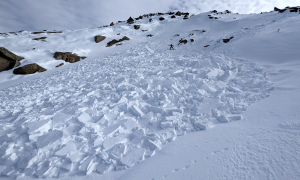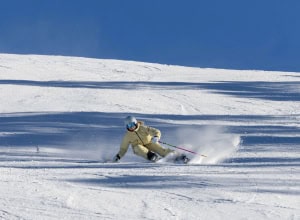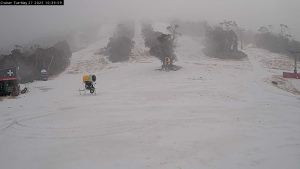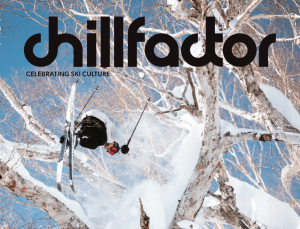HOW TO Choose Your Next Pair of Boots
![]()
Will now skis in freeride boots | Image: Hansen
Will Clifford
Former ski racer Will Clifford has used every type of ski boot around; from the high performance stiff boots of his ski racing days to the forgiving rear-entry numbers he used while nursing a back injury. Here explains the main different types of boot and they skiers they suit.
Choosing Boots
Choosing boots comes down to two simple things:
1. Choose a type of boot. What do you need it for? eg racing or freestyle
2. Choose the most comfortable boot in right the category.
Comfort
Comfort in boots is sometimes misunderstood, your foot should be snug inside the boot when done up. You might think a boot that fits like a slipper is nice, but if you have major movement you’ll get rubbing, which will cause blistering and even shin bang. Loose boots will also reduce the performance of your skiing – if you’re moving your foot to make a turn and it’s just slipping around inside your boot, your ski wont turn!
BUT, having a boot that is to tight will give you hot spots that will lead to bone spurs and growths and even loss of toe nails, it may stop you skiing from day to day. The only people that should have very tight boots are races looking for more and more performance – It’s really not fun, trust me!! I would never ski recreationally with boots anything like as tight as I did when I was racing, it’s pointless spoiling a good day’s skiing with sore feet. Having your boots super tight doesn’t mean you’re a better skier, it just means you’ll have to spend more money at the podiatrist!

Find the boot that fits right and does what you need it to | Image: Hotham
Ski boots can generally be put into four categories.
All-Mountain
This is the most generalised of all four groups. All-mountain boots are used by all standard of skiers. A comfortable, central standing position lets you enjoy a comfortable day skiing in any conditions. The main difference between boots in the all-mountain category is the foot shape they are designed for and the stiffness of the flex. Better skiers should go for a stiffer style and some boot companies aim at a wider foot – like Salomon – and other companies, like Technica and Rossignol, aim for a slim to normal foot. Most recreational skiers will find a boot in the all-mountain category to suit their needs.
I ski in Rossignol boots and I’ve found the Zenith Sensor3 110 to be a great all-mountain boot. It’s 50% on piste, 50% off, which would suit a strong skier who likes to go all over the mountain.
Freestyle
With Freestyle getting bigger, the boots are advancing more and more. Some companies are putting soft boot boards in the bottom of the shells to make landings soft. Some manufacturers are using super loud graphics to lure the buyer in. All sorts of ideas are being used in this category. These boots mainly come down to two designs. The traditional 4-buckle boot or the larger-tongue boot with two buckles. A lot of freeriders love the 2-buckle boot with the bigger tongue as it gives you a more consistent, softer flex. Freestyle boots are meant to be soft and definitely not too tight. If you’re looking for something really comfortable and forgiving, a freestyle boot could be a good option because they are designed to perform while still being soft.
Great freestyle boots are Rossignol SAS Pro Composite or the Nordica Ace of Spades, which are 60% park and pipe 40% resort.
Freeride
Freeride boots are very similar to freestyle; the main difference is the stiffness. Freeride boots are designed for skiing big mountains, skiing hard but still being comfortable. My personal opinion, freeride boots are as good as if not better then all mountain boots. They give you a little bit more of an aggressive stance, which enables a greater performance in your skiing. You will see a lot of Ski patrollers and ski instructors wearing freeride boots as they are a high performance boot that are comfortable and can be worn all day.
I ski in the Rossignol B-Squad sensor3 and don’t have any boot trouble. They are 80% off piste, 20% on but anyone who likes to seek out powder and switch from groomers to bumps to trees would find freeride boots a good option.

The Rossignol B-Squad sensor3
Race/High Performance
Traditionally the best skiers always skied in race boots but with the huge range of good new boots in other categories out there, race boots are no longer used as much. The stiffest and most aggressive type of boot, race boots put you right on the tongue of the boot in order to handle the forces and speed that comes from racing. A race boot is usually fitted tightly for performance, so skiing in the park would be a no go! The stiffer race boots are only used for racing. You can get less stiff race boots that are great for high performance skiing. The function of these boots comes down to skiing fast in the best possible position – I guess that’s why ski instructors use them!!!
I always raced in the the Rossignol Radical range and Nordica Dobermann range, which are ahead of their competitors. They are 80% on piste, 20% off and apart from racers they’d suit strong, powerful skiers with a lot of weight behind their turns who perhaps find even stiff all-mountain boots don’t support them enough.
Finally, to get the perfect boots, you have to have them properly fitted, ideally close to where you ski. You’d be amazed how much can be done to a boot to customise the fit – from stretching the shell to accommodate a long toe to building in special padding to protect corns or spurs. A boot fitter will do that as part of the price of the boots and if things aren’t right when you try them on the slopes, you can take them back for more adjustments – you don’t get that service from the internet!




